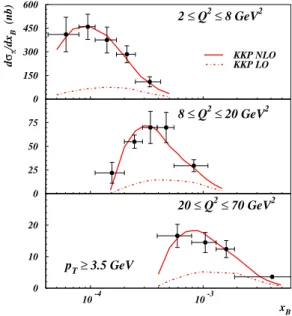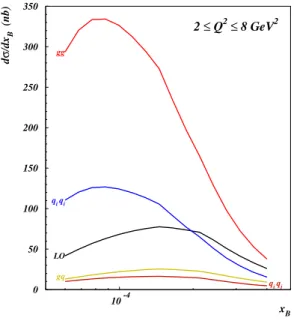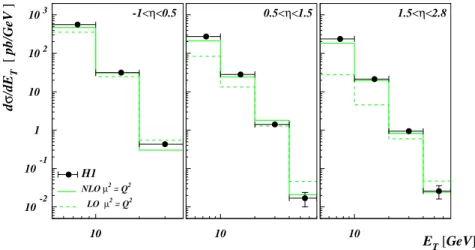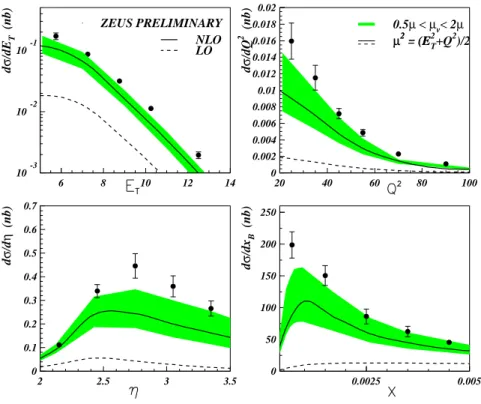NLO QCD Corrections to Inclusive Jet and Hadron Production in DIS
A. Daleo,
Institut f¨ur Theoretische Physik, Universit¨at Z¨urich, Winterthurerstrasse 190, CH-8057 Z¨urich, Switzerland
D. de Florian, and R. Sassot
Departamento de F´ısica, Universidad de Buenos Aires, Ciudad Universitaria, Pab.1 (1428) Buenos Aires, Argentina
Received on 3 December, 2006
We analyze the orderα2
s corrections to the single inclusive jet and hadron cross sections in lepton-nucleon deep inelastic scattering. The full calculations are done analytically, obtaining finite NLO partonic level cross sections for these processes. We show that in both cases the dominant partonic mechanism starts at orderα2
s, being effectively a lowest order estimate, with the consequent large factorization scale uncertainty, and the likelihood of non-negligible corrections at the subsequent order in perturbation theory.
Keywords: Semi-Inclusive DIS; Perturbative QCD
I. INTRODUCTION
Over the last thirty years, the DGLAP [1] approach to par-ton dynamics has demonstrated itself as the most adequate tool for the description of the energy scale dependence of a va-riety of lepton-nucleon, and nucleon-nucleon processes over a wide kinematical range. Surprisingly, not just this approx-imation, but the lowest order in perturbation theory within this approach (LO) gives fairly accurate estimates for para-digmatic processes such as inclusive deep inelastic scattering (DIS), provided an energy or momentum scale of a few GeV characterizes them. The following order (NLO) often repre-sents small corrections, required for precise comparisons, but not for the broad picture.
In the few last years high precision DIS experiments, with a wide kinematical coverage, and the ability to measure less in-clusive processes, such as those performed by the ZEUS and H1 collaborations at HERA, have extended the tests on the dynamics of partons to the limits of their kinematical reach, looking for signatures of dynamics complementary to that de-scribed by the DGLAP approach. Illustrative examples of these tests are the measurements of final state hadrons [2] and jets [3, 4] produced in DIS processes in the forward region, for which the LO DGLAP description fail to reproduce the data by an order of magnitude, and even NLO estimates fall short. In a recent analysis [5], it has been shown that the striking failure of the LO description in the case of forward hadrons by no means implies the breakdown of the DGLAP dynam-ics, but just the inadequacy of the LO picture, which simply does not include the dominant contribution to the measured cross section: the process in which an initial state gluon is knocked out from the nucleon, and also a gluon fragments into the detected final state hadron. Indeed, the NLO approxima-tion, which takes into account these contributions, reproduce nicely the data [5–7].
In the case of forward jets, the situation seems to be more compromised, because not only the LO estimates fail, but also NLO estimates fall short by a factor of two of the data [4]. In reference [3] this feature together with the large scale depen-dence of NLO calculations, has been taken as indicative of
the importance of higher order corrections. In order to im-prove the understanding of this situation, in reference [8] we also computed the orderα2
s corrections to the single inclusive
jet cross section in lepton-nucleon deep inelastic scattering. The NLO corrections to single inclusive jet production in DIS have been calculated within both the phase space slicing [9, 10] and the subtraction formalism [11, 12] in order to deal with the initial and final state singularities. At variance with these previous computations, we performed a completely ana-lytical calculation in the small cone approximation [13]. This approximation allows us to translate straightforwardly previ-ous results on hadroproduction [5] to the case of jets, avoiding a rather cumbersome calculation and delicate numerical treat-ments for dealing with the collinear singularities.
Our main conclusion is that, as in the case of hadroproduc-tion, the dominant partonic process in the most forward jet region accessed yet is the one with a gluon in the initial state and also a gluon as the main seed of the jet. This process starts at order α2
s, and makes the NLO effectively a lowest
order estimate, with the consequent large factorization scale uncertainty, and the likelihood of non-negligible corrections at the subsequent order in perturbation.
II. SINGLE-INCLUSIVE PROCESSES.
Single inclusive jet production is similar to one particle pro-duction in the sense that we focus in the propro-duction of a sin-gle jet of particles from final state partons, and thus we expect a similar pattern of higher order corrections. Here however, there are no fragmentation functions, since partons fragment into unspecified hadrons with unit probability. This means also that we have no right to factorize final state collinear singularities into them. All final state singularities must can-cel when we consider a physically meaningful jet observable. This, of course, modifies the effective scale dependence in the cross section.
From a more formal point of view, the analytic computa-tion of higher order QCD correccomputa-tions to one particle inclusive cross sections has always lagged behind that of more inclusive observables, and the reason is the much more involved singu-larity structure [16, 17]. As usual in these corrections, dia-grams are plagued with collinear singularities that have to be identified, prescribed, and canceled to get the physical cross section, but at variance with the inclusive case, here one has to deal typically with overlapping singularities in several vari-ables, which is a real technical challenge.
For finite transverse momentum, however it is much eas-ier, and the argument is simple: At the lowest order in the cross section, hadrons can only be produced anti parallel to the proton, this implies that the first order contributions are finite from the collinear point of view, and the second order con-tributions have simple collinear singularities, otherwise they couldn’t be factorized. Then, choosing the appropriate vari-ables at partonic level the
O
(α2s), singularities have the same
structure as in the inclusive case at
O
(αs). Of course, for this same reason we have to go one order further than usual in order have a good perturbative approximation.Specifically, the process we are considering is one in which a lepton scatters of a proton and a final state hadron is tagged.
l(l) +P(P)−→l′(l′) +h(P
h) +X, (1)
The cross section will be given by a convolution of a parton density, a fragmentation function, and the partonic level cross section:
dσh
dxBdQ2
= ∑i,j,n
Z 1
0 dξ
Z 1
0 dζ
Z
dPS(n) (2)
fi(ξ)Dh/j(ζ)
dσ(i jn)
dxBdQ2dPS(n)
.
whereσ(i jn)is the partonic level cross section corresponding to the process
l(l) +i(pi)−→l′(l′) +j(kj) +n-1 additional partons, (3)
before renormalization of the coupling constant and factoriza-tion of collinear singularities. fi(ξ)andDh/j(ζ)are the bare
parton densities and fragmentation functions, and dPS(n)the n-parton phase space.ξis the proton momentum fraction car-ried by the partoniandζis the fraction of partonjmomentum taken away by the final state hadron. In addition, we define the
usual DIS variables,
Q2=−q2=−(l′
−l)2, xB=
Q2
2P·q, (4) ye=
P·q
P·l, SH= (P+l)
2. (5)
Integrating the cross section over the spectator partons and prescribing the singularities we obtain a cross section that has the same singularity structure as in inclusive DIS at
O
(αs):dσ(i j2)
dxBdQ2dy dz
= cqC
2 ε
ξx2BS2H (6)
½
1 ε
P
(2)
1i j(ρ,y,z) +C
(2)
i j (ρ,y,z) +
O
(ε)¾
,
The standard NLO definitions for parton densities and frag-mentation functions automatically cancel these remaining sin-gularities. Of course, the coefficients are rather long because they include the finite terms of
O
(α2s), which only show up at
NNLO in the inclusive case.
At NLO, which for this processes is
O
(α2s)in the cross
sec-tion, we have the following real and virtual contributions ini-tiated by either a quark or a gluon, and any of the final state partons can be attached to a fragmentation function, one at a time.
Real contributions
γ+q(q¯) → g+g+q(q¯) γ+qi(q¯i) → qi(q¯i) +qj+q¯j
γ+qi(q¯i) → qi(q¯i) +qi+q¯i
γ+g → g+q+q¯
Virtual contributions
γ+q(q¯) → q(q¯) γ+q(q¯) → g+q(q¯)
γ+g → q+q¯
Notice that compared to the previous order, we have new channels, for example the one in which a gluon initiates the process and also a gluon fragments, corresponding to the dia-grams in Fig. 1
III. PHENOMENOLOGICAL IMPLICATIONS
The obvious question at this point is if computing all the
O
(α2s)contributions are worth the effort. The answer should
be found in K-factors, which are defined as the ratio between the NLO and the LO predictions. And the answer seems to be negative, as shown in Fig. 2, because the K-factor as a function of transverse momentum for a photon virtuality of 200 GeV2 in a wide range Bjorken momentum fractions is, as usual, less than a 20% effect far from the factor of four we need to match the data.
pT (GeV)
K=d
σ
NLO
/d
σ
LO
xB = 0.005
xB = 0.01
xB = 0.02
Q2=200 GeV2
0.6 0.8 1 1.2 1.4
4 6 8 10 12 14 16
FIG. 2: K-factor as a function ofpT.
We still have the arbitrariness in choice for the renormal-ization and factorrenormal-ization scale. The standard choice would be to take some combination between the transverse momentum and the virtuality of the photon, which are most conspicuous scales in the problem, i.e.
µ20=(Q
2+p2
T)
2 . (8)
Varying this scale as much as a factor of ten around the stan-dard choice the cross section varies but not enough to explain H1 data, as shown in Fig. 3.
µ2
/µ20
d
σ
(
µ
)/d
σ
(
µ0
)
NLO LO
pT≥ 3.5 GeV xB = 0.01 Q2 = 200 GeV
0.5 1. 1.5 2
10-1 1 10
FIG. 3: K-factor as a function of the scale.
It is worthwhile at this point to have a closer look at the data, which correspond to neutral pions produced in positron
proton DIS processes in these rather stringent cuts on the an-gle and pion energy fractions [2]. As a function of Bjorken momentum fraction, the measured cross section looks as shown in Fig. 4 in differentQ2bins. The LO prediction badly underestimates the data, however when we switch on NLO corrections, the situation changes dramatically: NLO correc-tions are huge.
0 150 300 450 600
0 25 50 75
d
σπ
/dx
B
(nb) 2 ≤ Q
2≤
8 GeV2
KKP NLO KKP LO
8 ≤ Q2≤ 20 GeV2
xB
20 ≤ Q2≤ 70 GeV2
pT≥ 3.5 GeV
0 10 20
10-4 10-3
FIG. 4: NLO cross sections, against H1 data [2]
But what is so special about this observable, that makes so important the corrections, even if they were not in the K-factors shown in Figs. 2 and 3? The answer is the kinemat-ical cuts. In Fig. 5 we see again the K-factor as a function of Bjorken x with and without H1 cuts on angle and energy fractions. Applying cuts, the K-factors can become as large
xB
K=(d
σ
NLO
/dx
B
)/(d
σ
LO
/dx
B
)
H1 cuts No cuts 2 ≤ Q2≤ 8 GeV2
0 5 10 15
10-4
FIG. 5: K-factors with and without cuts
gluon to gluon process. In Fig. 6 here we have the LO con-tribution as a white line and the different NLO concon-tributions discriminated.
xB
d
σ
/dx
B
(nb) 2 ≤ Q2≤ 8 GeV2
LO gg
qi qi
gq
qi qj
0 50 100 150 200 250 300 350
10-4
FIG. 6: Contributions to the cross section
In the case of the NLO jet cross section again the most striking feature is the growth of the NLO corrections as the rapidity of the jets increases. In Fig. III we plot the cross sec-tion in three regions of rapidity as a funcsec-tion of transverse jet momentum. We include the data of H1 [18] for comparison. NLO corrections, which are moderate for central rapidities, become significantly large in the forward region.
In Fig. 8 we show the different partonic contributions in the three rapidity regions. While in the central region the LO contribution is very close to the full NLO estimate, in the for-ward region it is significantly smaller. In the former the cross section is dominated by the σg→q contributions, which are
already present at LO, while in the latter the dominants are σg→g, which are pure NLO.
Since the dominant partonic process in the forward region is accounted at NLO for the first time, it is effectively a LO estimate and most probably receives significant higher order corrections. The first round of corrections for other partonic processes in this kinematic region rise typically to 50%
ef-fects, so it would not be surprising that the NLO estimate falls short of the data, specially if a more stringent kinematic range is explored. This is precisely what the ZEUS collaboration has reported in preliminary analyses of measurements in the very forward region [19].
In Fig. 9 we plot the NLO estimates as distributions in dif-ferent variables together with ZEUS preliminary data for ra-pidities between 2.0 and 3.5 [19]. The NLO estimate falls short of the data, and only allowing a rather large scale uncer-tainty it may be considered consistent with the measurements, specially at smallxB.
Again theσg→g contributions dominate the cross section,
specially at lowxBwhere the gluon parton density grows
dra-matically and in the middle of the rapidity range, as shown in Fig. 10. In these two regions one can expect the first order corrections to these processes, starting at NNLO, to be signif-icant. In fact, it is there where the NLO estimate can be more distant to the data with a particular choice for the scale, and where NNLO corrections became really necessary.
IV. CONCLUSIONS
We have computed the single inclusive jet and hadron deep inelastic scattering cross section at
O
(α2s). In both cases we
have found that the dominant partonic processes in the very forward region start at orderα2
s, being effectively a lowest
order estimate. As in any lowest order calculation, there is a large factorization scale uncertainty which can not be ne-glected, and it is likely that there will be large corrections at the subsequent order in perturbation. Rather than a break-down of the DGLAP approach, these processes seem to open a window to NNLO. This feature is expected to be even more apparent at higher rapidities, and the corresponding measure-ments will constitute an obligatory benchmark for the study of QCD at NNLO.
Acknowledgments
Partially supported by CONICET, Fundaci´on Antorchas, UBACYT and ANPCyT, Argentina. R.S. warmly acknowl-edges M. B. Gay Ducati, and the Local Comitee of the I Latin American workshop on High Energy Phenomenology for their hospitality during the meeting where this talk was presented.
[1] V. N. Gribov, L. N. Lipatov, Yad. Fiz.15, 781 (1972) and 1218 [Sov. J. Nucl. Phys.15, 438 and 675 (1972)];
Y. L. Dokshitzer, Sov. Phys. JETP 46, 641 (1977) [Zh.Eksp.Teor.Fiz.73, 1216 (1977)];
G. Altarelli and G. Parisi, Nucl. Phys. B126, 298 (1977). [2] A. Aktaset al.[H1 Collaboration], Eur. Phys. J. C 36, 441
(2004) [arXiv:hep-ex/0404009].
[3] S. Chekanovet al.[ZEUS Collaboration], hep-ex/0502029. [4] A. Aktaset al.[H1 Collaboration], hep-ex/0508055.
[5] A. Daleo, D. de Florian, and R. Sassot, Phys. Rev. D71, 034013 (2005) [arXiv:hep-ph/0411212].
[6] B. A. Kniehl, G. Kramer, and M. Maniatis, Nucl. Phys. B711, 345 (2005) [Erratum-ibid. B720, 345 (2005)]
[7] P. Aurenche, R. Basu, M. Fontannaz, and R. M. Godbole, Eur. Phys. J. C 34, 277 (2004). [arXiv:hep-ph/0312359].
[8] A. Daleo and R. Sassot, arXiv:hep-ph/0511189.
10-2
10-1
1 10
102
103
10 10
d
σ
/dE
T
[
pb/GeV
]
NLO µ2 = Q2 LO µ2 = Q2
H1
-1<η<0.5 0.5<η<1.5 1.5<η<2.8
ET[GeV]
10
FIG. 7: Jet cross sections in H1 kinematics
200 400 600 800 1000 1200
10
100 200 300 400 500 600
10
d
σ
/dE
T
[
pb/GeV
]
100 200 300 400 500 600
10
FIG. 8: Contributions to the jet cross section
[10] G. Kramer and B. Potter, Eur. Phys. J. C 5, 665 (1998) [arXiv:hep-ph/9804352].
[11] S. Catani and M. H. Seymour, Phys. Lett. B387, 287 (1996); S. Catani and M. H. Seymour, Nucl. Phys. B485, 291 (1997) [Erratum-ibid. B510, 503 (1997)].
[12] D. Graudenz, arXiv:hep-ph/9710244.
[13] G. Sterman and S. Weinberg, Phys. Rev. Lett.39, 1436 (1977), M. A. Furman, Nucl. Phys. B197, 413 (1981).
[14] A. D. Martin, R. G. Roberts, W. J. Stirling, and R. S. Thorne, Eur. Phys. J. C 28, 455 (2003) [arXiv:hep-ph/02112080]. [15] B. A. Kniehl, G. Kramer, and B. Potter, Nucl. Phys. B 582, 514
(2000) [arXiv:hep-ph/0010289].
[16] A. Daleo and R. Sassot, Nucl. Phys. B 673, 357 (2003) [arXiv:hep-ph/0309073].
[17] A. Daleo, C. A. Garcia Canal, and R. Sassot, Nucl. Phys. B662, 334 (2003) [arXiv:hep-ph/0303199].
[18] C. Adloffet al. [H1 Collaboration], Phys. Lett. B 542, 193 (2002) [arXiv:hep-ex/0206029].
10-3
10-2
10-1
6 8 10 12 14
0 0.002 0.004 0.006 0.008 0.01 0.012 0.014 0.016 0.018 0.02
20 40 60 80 100
0 0.1 0.2 0.3 0.4 0.5 0.6 0.7
2 2.5 3 3.5
d
σ
/dE
T
(nb)
NLO LO ZEUS PRELIMINARY
d
σ
/dQ
2 (nb)
0.5µ<µv< 2µ
µ2
= (ET+Q2)/2
µ2 = (E2
d
σ
/d
η
(nb)
d
σ
/dx
B
(nb)
0 50 100 150 200 250
0.0025 0.005
FIG. 9: Jet cross section and Zeus preliminary data
0 0.05 0.1 0.15 0.2 0.25
2 2.5 3 3.5
0 0.05 0.1 0.15 0.2 0.25
0 20 40 60 80 100 120
0.002 0.004
d
σ
/d
η
(nb)
d
σ
/dx
B
(nb)
d
σ
/dE
T
(nb)
0 0.02 0.04 0.06 0.08 0.1 0.12
5 10



